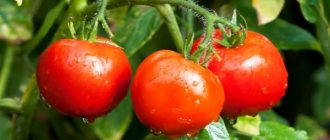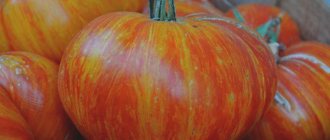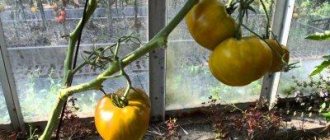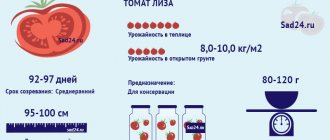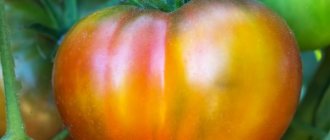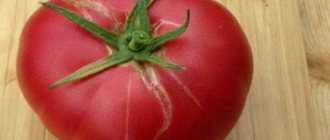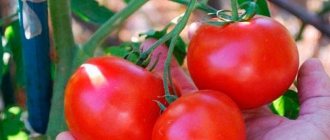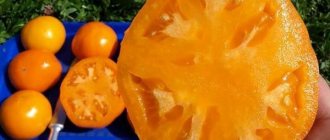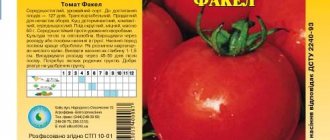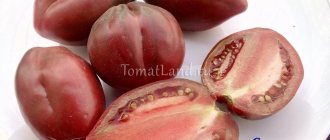Growing from seeds to seedlings at home
When buying seedlings on hand, there is no guarantee that it will be the King of the Early, so you can try to grow the seedlings yourself.
Seed preparation
First of all, it is important to choose seeds that are more than two years old. Seed preparation includes several stages:. Seed preparation includes several stages:
Seed preparation includes several stages:
- soaking in a weak solution of potassium permanganate for 30 minutes;
- rinsing under running water;
- keeping in a growth stimulator for 12 hours;
- hardening in the refrigerator - overnight;
- drying.
Did you know? It is believed that tomatoes come from Peru, or more precisely, from the coastal strip between northern Chile and Ecuador. This culture was cultivated there long before the arrival of Europeans.
Seed planting process
Prepared seed can be sown in early March in cassettes, peat tablets or special boxes. The earth is pre-moistened. It is convenient to take the seeds with a toothpick or use a hand seeder. When sowing, 3 pieces are placed in containers or tablets. into one cell. They are placed in boxes at a distance of 3 cm, with a distance of 4 cm between rows. Sprinkle them with earth no more than 2 cm and moisten them with a spray bottle. The containers are covered with a lid, glass or film and placed in a warm and dark place.
Seedling care
After thin threads of seedlings appear, the seedlings are placed closer to the light and the covering is removed. You need to water as the top layer of soil dries, making sure that the drops do not fall on the leaves. Plants are turned towards the light every two days so that they grow evenly. At the stage of two true leaves, the seedlings dive. 2 weeks after picking, you can start feeding fertilizers for seedlings. Before planting in open ground, there can be three feedings.
When the tomatoes grow to 15 cm, they begin to harden off before planting outside. Start doing this for 30 minutes at a temperature not lower than +15°C. To do this, the containers are placed on the balcony or veranda in the evening. The time is increasing every day. Also, tomatoes are gradually accustomed to sunlight, removing shading after 16 hours.
Find out also about the best varieties of tomatoes that are resistant to late blight.
Immediately before planting, plants can be treated with copper sulfate to prevent disease.
Transplanting seedlings into the ground
Tomatoes are planted in the greenhouse when they reach 20 cm in height. This is approximately the beginning of May. It’s too early to plant in open ground; you’ll have to wait another three weeks. Our grandmothers were guided by the 20th of May, when there was no longer a risk of frost returning.
Planting is carried out on a cloudy day, preferably rainy. In the prepared area, holes are made for half a shovel at the rate of 6 pieces per m². This variety should not be placed more densely, as it produces many side branches that will interfere with walking between the bushes. Or you will have to regularly remove excess parts. The distance between rows should be about a meter.
1 liter of water is poured into each hole and a handful of ash is placed. You can add onion peels. The seedlings are carefully removed from the containers, being careful not to damage the roots. The longest central root is cut in half. The tomato is lowered into the hole, sprinkled with soil and compacted. When all the plants are planted, each is watered with water heated in the sun. You can mulch the ground around with peat or sawdust to retain moisture well.
Important! As a result of heat treatment, the beneficial properties of tomatoes only improve
Growing
Cultivation of King of Kings tomatoes, according to reviews and photos, is carried out using seedlings. Productivity is influenced by compliance with planting and care rules.
Growing seedlings
The optimal time for the procedure is from mid-April to the first weeks of March. Transplantation into open ground is carried out 70 days after planting the seeds for seedlings.
It is recommended to purchase seed material from trusted suppliers. Before planting, it is necessary to check the expiration date of the seeds and process them.
Samples that have defects, strange shapes or colors are unsuitable for sowing. To check the germination of the seed, you need to dissolve a teaspoon of salt in a glass of warm water and put future tomatoes in it. Seeds suitable for planting will remain at the bottom after 10 minutes, hollow samples will float to the surface of the water.
As a disinfection procedure, seed material is immersed in a 0.05% chlorhexidine solution for 30 minutes, then washed with water and dried thoroughly.
A day before planting, it is recommended to place the seeds in a solution with a growth stimulator and prepare the containers. Containers must be clean, dry, and have ventilation holes.
Rules for planting tomato seeds:
- distribute a drainage layer (small stones or expanded clay) along the bottom of the container;
- pour soil into the container and thoroughly moisten it;
- sow seeds in grooves 1 cm deep, maintaining a distance between rows of 3 cm;
- lightly sprinkle the planting material with soil, moisten the soil with a spray bottle;
- Cover the box with plantings with glass or film, move the containers to a sunny and warm place.
After the emergence of shoots and 2-3 leaves, the King of Kings tomatoes need to be transplanted into separate containers.
Caring for seedlings involves timely loosening and watering, providing a sufficient amount of sunlight. It is recommended to regularly ventilate the room where the containers are located.
Landing rules
Transplantation into open ground is carried out when the soil has warmed up to + 15 °C. 10-14 days before the procedure, it is recommended to harden the plants: take containers with tomatoes outside on sunny days, gradually increasing the time they spend in the fresh air.
Before planting, the soil is dug up and beds are formed. It is possible to place no more than 3 bushes per 1 m2. The distance between seedlings should be 40 cm, and the row spacing should be 0.5 m.
Before planting, the plant is moistened abundantly, after which it is carefully removed from the pot so that the root system remains intact, and moved into the hole, covered with earth, and watered.
Watering and fertilizing
Moistening the soil is carried out as necessary: warm water is poured onto the soil in the morning or evening hours so that moisture does not fall on the leaf blades and does not erode the root system.
The first fertilizing is carried out immediately after planting, adding fertilizers with phosphorus to the soil. During the period of flowering and formation of ovaries, it is necessary to provide the tomatoes with nitrogen, and during the period of fruit ripening with fertilizers containing potassium.
Pinching and tying
Tall tomatoes King of Kings need pinching. The first procedure is carried out when the bush reaches 6 cm in height: the lower shoots are removed. During the entire growing period, it is recommended to carry out 3 prunings. During the procedure, you should also pinch the tops of the plant so that the bush slows down its growth and directs its forces to ripening the fruits.
Immediately after transplanting the crop into open ground or as the variety grows, it is necessary to tie it up. This avoids damage to tomatoes from gusts of wind and provides support for branches with fruits. Wooden or metal stakes, mesh and other available devices are used as support.
Formation
For King of Kings tomatoes, forming 1 or 2 stems is a mandatory procedure. The first brush is placed above the 9th leaf, the rest every 3 leaf plates.
Formation is carried out gradually as the bush grows. If the procedure is neglected, the branches bend to the ground under the weight of the fruit and break.
Protection from diseases and pests
King of Kings tomatoes are highly resistant to diseases that affect tomatoes. The pest that attacks the variety is the whitefly. It is capable of completely destroying all plantings within a short period of time.
The butterfly is small in size (up to 3 mm), drinks juice from the leaf plates and branches of the plant, which turn pale and then lose color as the pest is active. Without treatment, the tomato dies.
The first inspection of King of Kings tomatoes is recommended 10-12 days after transfer to open ground. If it is detected, it is important to treat all bushes with special preparations: Mospilan or Actellik.
Tomato King of the Market - full review of the variety
The King of the Market variety was developed by Russian breeders in the early 2000s. Initially, it was developed for the needs of industrial production, so first of all, the tomato gained popularity in the large market. However, soon its positive qualities were noted by ordinary farmers.
It appealed to many professional gardeners and summer residents, causing them a large number of positive reviews, and the originator - an incentive to select new hybrids specifically for owners of small gardens.
Since the introduction of the first Market King, this series has expanded significantly and now has 13 officially registered representatives. Although the new varieties differ from their ancestor, in general all tomatoes of this variety have similar properties.
Distinctive features
Most varieties of the variety are classified as hybrids for open ground - 9 out of 13 tomatoes of the King of the Market variety are determinate.
The exceptions are four indeterminate varieties: Pink Market King No. 8, Giant King No. 9, Pickling King No. 11 and Honey King No. 12. They are suitable for planting both in open ground and in greenhouses.
Photos of varieties of the King of the Market variety:
In determinate tomatoes of this type, the bush is low-growing and slightly stretches upward. The growth stage quickly ends with a flower cluster. Such a bush grows to a maximum of 100 cm. Indets reach up to 1.5 m in height.
In both subspecies, during growth the bush forms two stems. They grow strong and thick, but, nevertheless, they still need to be tied up due to the abundance and heaviness of the fruit.
According to professional breeders, tomatoes of the King of the Market F1 variety have the following advantages:
- grow well in arid climates;
- tolerate sudden fluctuations in temperature and humidity without problems;
- resistance to the main complex of tomato diseases and cracking;
- rarely become an object of interest for pests;
- uniform and abundant harvest on all bushes;
- suitable for consumption both fresh and processed;
- Thanks to their thick skin, they tolerate transportation and storage well.
Among the disadvantages, gardeners from non-southern regions point out their increased heat-loving nature - such tomatoes germinate more slowly and set trusses in the middle zone, but it is not recommended to grow them in the northern regions.
Many summer residents also find a disadvantage in the fact that “kings” cannot be preserved in their entirety due to their large fruits. However, they are gladly used for drying, barrel or tub salting.
Fruit characteristics and yield
Almost all fruits of the King of the Market variety are visually similar. In appearance, all representatives of this variety are perfectly even and smooth. The taste of the fruit, starting with Market King No. 4, was improved, so later hybrids are distinguished by a sweet taste and aroma, as well as juicy and elastic pulp.
When ripe, tomatoes acquire a bright red color and have a round, slightly elongated shape. Tomatoes of other colors were specially bred in the series - Pink Market King No. 8 and Orange Market King No. 13. Obvious differences in shape are observed in the King of the Market No. 2 and in the King of Salting No. 11 - they have a cylindrical shape, similar to cream.
As for the weight of fruits, on average it varies from 180 to 300 g. The varieties King of the Market No. 7 and King Giant No. 9 stand out from the general picture with fruit weights of 400-600 and 400-1000 g, respectively.
The yield of the Market Kings is average among other hybrids - from 9 to 13 kg per 1 m². The average fruit yield per bush is extremely high – 92%.
Photos of unusual varieties of the King of the Market variety:
Plant care
The king of the market is a fairly unpretentious hybrid. It is flexible and adapts to almost any conditions. But if you want to get a really good harvest, then you should follow the watering and fertilizing regime, as well as perform agrotechnological techniques (tying, weeding, loosening).
Watering rules
Rules for watering tomato King of the Market:
- Use warm, settled water.
- Watering is carried out at the root. Leaves and inflorescences should not be irrigated.
- On average, one bush requires 5 liters of water. During the flowering period and before fruit formation, the amount of water is increased to 10 liters.
- The frequency of watering depends on weather conditions. Both the top layer of soil should not dry out or become waterlogged. On average, the frequency of watering is 1-2 times a week.
Top dressing
To provide nutrients, the plant is fed with nitrogen fertilizers two weeks after planting and with phosphorus-potassium complexes during flowering and fruiting (once every 2-3 weeks). Tomato also responds well to organic fertilizing (0.5 liters of mullein or bird droppings diluted in 10 liters of water). At the end of July, feeding is stopped so as not to promote the growth of green mass to the detriment of fruit ripening.
Read about the features of applying fertilizers for tomatoes.
Stepping and bush formation
The King of the Market does not require mandatory pinching, but some farmers form a bush with 2 stems, removing unnecessary shoots every 11 days. Without stepsoning, the King of the Market will give a later, but also more abundant harvest.
Regardless of whether you are engaged in the formation of a bush, it needs to be tied up, since most of the hybrids in the series have large fruits, which, combined with high productivity, requires fixing the plant to preserve the tomato. The bush is tied to pegs or a trellis is made. It is better to use synthetic materials for garters (they do not rot and are more durable).
Loosening the soil and weeding
After watering, the soil is loosened to a depth of 4-5 cm. Careful weeding is also necessary: all weeds are removed by the roots to prevent pest infestation. To simplify this work, a tool such as a Fokin flat cutter is used.
Did you know? The Fokina flat cutter is such a popular tool that it is often counterfeited. The original flat cutter has a black blade, and its handle is never painted.
Pests and diseases of the variety
The Market King has excellent immunity against the most common diseases: fusarium, tobacco mosaic, gray rot, late blight. However, improper care can lead to the development of certain diseases and pest damage.
Let's consider the main threats to the health of tomatoes and methods of their treatment and prevention:
- Alternaria blight is a fungal disease that affects the stem, leaves and fruits. The reason for the development is non-compliance with crop rotation and a combination of hot weather with high rainfall. To get rid of Alternaria fungicides “Tattu” and “Antrakol” are used.
- Black spot is much more dangerous than Alternaria blight. It is characterized by the rapid spread of dark spots on the leaves. The leaves fall off, and the fruits rot and do not ripen. If a disease is detected, the affected plant must be removed and burned, and the entire area surrounding it must be treated with Bordeaux mixture. Black spot can be prevented by regular fertilizing with mineral fertilizers, timely weeding, non-thickening of plantings and adherence to crop rotation.
- The mole cricket damages the roots of tomatoes, it is especially dangerous for young seedlings. Thorough weeding will serve as prevention, and if the mole cricket is already annoying you, the drug “Thunder”, whose granules are laid out in moistened soil to a depth of 3-5 cm, will be a great help.
- To combat the Colorado potato beetle, which feeds on tomato leaves, the chemical preparation “Prestige” is used, and plants and soil are dusted with sifted ash.
- The netted slug usually appears in the cold, rainy summer and feeds on tomato foliage, leaving holes and a silvery slimy trail. This is not only unaesthetic, but also entails a slowdown in the growth of tomatoes and the death of flower stalks. In addition, the slug spreads infections and fungi. Slugs are collected by hand and destroyed. “Biological weapons” such as parasitic nematodes are also used. This microorganism is safe for both humans and tomatoes. The nematode is sold packaged in boxes in specialized stores. Another good means of prevention is to plant onions and garlic between rows.
Growing and care
Tomatoes are planted in holes at a distance of 45-50 cm with nearby supports. Add 1 tbsp into the wells. phosphorus-potassium mixture, a handful of compost and peat.
Agricultural practices are carried out in accordance with the rules for indeterminates. Bushes are formed into 1-2 trunks, and side shoots are systematically planted. Folk remedies are used to treat bushes and stimulate fruiting:
- iodine;
- yeast;
- ash;
- peroxide;
- onion peel;
- boric acid.
For root feeding, bio-infusions from nettle and diluted mullein are used. Good results are achieved by watering with such complex preparations as:
- Blank sheet
- Fusco
- Florizel
- Agricola.
Tomato “King of Kings”: variety description
| Variety name | King of Kings |
| general description | Indeterminate, mid-late variety of large-fruited tomatoes |
| Originator | Institute of General Genetics named after. Vavilova RAS |
| Ripening period | 110-120 days |
| Form | The surface is slightly ribbed, smooth, the shape is round, slightly flattened. The pulp is dense, fleshy, not too juicy |
| Color | at maturity bright red color |
| Average weight of tomatoes | from 200 grams to 1.5 kg |
| Application | Table appointment. Perfect for making salads, can be processed into juices, pastes, and purees. Not used for canning or pickling. |
| Productivity of the variety | 7-8 kg per square meter |
| Features of cultivation | Sowing 65-70 days before planting, no more than 3 plants per 1 sq.m., forming into 1-2 stems with mandatory tying to a support. |
| Disease resistance | Resistant to late blight, susceptible to whitefly attack |
This is a fairly new variety. There is very little information about him. The originator is the Institute of General Genetics named after. Vavilov RAS. Included in the State Register of the Russian Federation for personal plots and farms only in the mid-2000s. Suitable for growing indoors. Basic .
The King of Kings is a complex F1 hybrid. This means that there is no point in collecting seeds from ripened fruits yourself, since they will not be able to grow the same plant. To do this, you will have to purchase an original package of seeds every year.
The bush is not standard, about 1.5-2 m high, highly branched, medium leafy. It requires careful shaping and pinching. The first brush begins to be laid above the 9th leaf, and the rest - every 3 leaves. Form a plant on 1 or 2 stems. Be sure to tie it to a long, strong support.
This is a late or mid-late ripening hybrid. From planting seeds for seedlings to harvesting, it takes about 110-120 days. Greenhouse cultivation is suitable for central Russia. To the south - cultivation is possible without shelter, in open ground.
It has good resistance to late blight. Read about varieties with the same quality here. You can also learn from our article how to grow a good crop of tomatoes in open ground.
With proper care, timely fertilizing with the right fertilizers, and watering, the yield of the “King of Kings” hybrid is extremely high - up to 5 kg per bush. According to reviews from experienced gardeners, when planting such tomatoes in film greenhouses, the yield is slightly higher than when grown in large glass or polycarbonate greenhouses.
In the table below you can see what the yield of other tomato varieties is:
| Variety name | Productivity |
| King of Kings | 5 kg per bush |
| Grandma's gift | up to 6 kg per bush |
| Brown sugar | 6-7 kg per square meter |
| Premier | 6-9 kg per square meter |
| Polbig | 3.8-4 kg per bush |
| Black bunch | 6 kg per bush |
| Kostroma | 4.5-5 kg per bush |
| Red bunch | 10 kg per bush |
| Lazy | 15 kg per square meter |
| Doll | 8-9 kg per square meter |
Agricultural technology
Seeds should be purchased in stores, as this is a proven way to purchase good material for planting. Still, it would be a good idea to check the integrity of the bag, as well as ask the seller whether there was any pre-treatment for disinfection purposes. If not, you need to do it yourself. The seeds are soaked in a pale manganese solution for disinfection, and then in a growth stimulator.
Variety seeds
Tomato king of Siberia
The soil must be good; it will be more profitable to buy ready-made soil, specially designed for tomatoes, but you can prepare it yourself.
You need to prepare soil for tomatoes in the fall. You can store it in a box placed outside. In winter, thanks to frost, all bacteria will die, and the soil will be ready for planting tomatoes. The mixture is prepared independently from soil, compost and humus, taking equal parts of each component. You can add ash, potassium sulfate and superphosphate.
The soil should be loose and saturated with useful substances. The level of humidity and the desired acidity are important.
Important information! You should not plant seeds of the King of Kings variety after potatoes, peppers, eggplants, and physalis.
In addition to the soil, you need to think about the conditions in which the tomatoes will grow. To obtain healthy early seedlings they should be like this:
- In the room reserved for seedlings, the air should be constantly heated to 25 degrees;
- The required air humidity is maintained at 55-70 percent;
- Additional lighting is used, especially if it is not possible to place the seedlings on the south side. To do this, install fluorescent lamps with a power of 40 watts. Additional light is needed for 8 hours a day. The height of the light bulbs above the planting is approximately 10 cm.
How to care for seedlings
Before planting in open areas, an intermediate step is required to properly maintain the seedlings:
- Water every 4 days after germination, then watering can be done a little less often, it all depends on the drying of the soil. If it is slightly dry, then moisture is required. It is advisable not to touch the leaves when watering along the stem;
- With proper soil preparation, feed only 1-2 times. Fertilizer is prepared from mullein infusion, or you can buy ready-made fertilizer;
- The soil is pre-hardened two weeks before planting the seeds. This is in order to obtain high yields in the future. The sprouts are also hardened off, but after the formation of 4-5 leaves. Boxes or containers are taken into a room with a lower temperature for a short time, increasing the duration of the procedure every day.
First green shoots
Landing in the ground
Transplanting seedlings to the garden bed after 60-70 days should take place on a day without precipitation, but cloudy. Sprouts are planted every 40-50 cm.
Important! As the plant grows, it needs to be pinched, weeded and tied to trellises or other supports in a timely manner.
Watering
The Tomato King in the garden is watered when the need arises, but approximately every 3-4 days. Warm water is needed, water it at the root. Moisture should not get on the leaves because of the possibility of fungal development.
Loosening and weeding
As is the case with other crops, they weed each time after watering and immediately loosen them. At first, you need to loosen not very deeply, without damaging the small roots. As they grow, hilling is added to these operations.
Stepsoning
It is one of the main conditions for obtaining a good harvest. Pinching involves pinching the tops, starting from the lower stems. It is recommended to do this procedure 2-3 times during the entire growth period.
Garter
The royal tomato needs a garter for a number of reasons:
- Increased receipt of necessary sunlight and ventilation;
- Prevention of bush breakage with significant weight of ripened tomatoes;
- On the ground, fruits are more easily attacked by pests.
Tie up with:
- Wires on the frame;
- Kolyev;
- Trellis horizontal and vertical;
- Grids;
- Hedges.
The King of Kings tomato variety is best tied up using a horizontal trellis, which holds the plant and prevents spoilage of the fruit. Wooden stakes are dug in and a rope is pulled between them.
Horizontal garter
Top dressing
Every two weeks, the King tomato needs to be fed with complex fertilizers. You can purchase fertilizers in a store or market, or make a nettle tincture at home, which contains vitamins and helps strengthen the plant’s immunity.
Pests and diseases
Tomato King may be susceptible to diseases:
- Fungus on leaves in the form of brown spots. The spots grow over time and the leaves dry out completely. It is called macrosporiosis;
- An infection with brown stripes on the stem and spots of the same color on the leaves and petioles. Name – tomato streak;
- Another fungus, but with watery spots on the fruit. The tomatoes are rotting and covered with white mold. This is the so-called gray rot;
- With weakened roots and lack of phosphorus, the foliage curls and a physiological disease occurs.
Harvest: collection and storage
It is best to harvest in the morning, after the dew has dried. Tomatoes can ripen at home in a dark place.
Harvest of the King of Kings
Attention! The absence of a green rim around the stalk indicates full ripening of the tomato.
The harvest should be stored in wooden boxes, in a ventilated room, at a low temperature of up to +6 degrees. The tomatoes are washed, wiped and placed tightly in rows. So they can lie and not lose their properties for up to two months.
Characteristics
Looking through the description, it becomes clear that all these descriptions have one thing in common - the tomatoes should be large-fruited. But everyone has their own vision of the “king” further.
Description of the variety
“Biotechnics” guarantees excellent taste, fleshiness and red color of fully ripened tomatoes, as well as excellent keeping quality until November, which is quite possible for a late tomato.
The tomatoes are fleshy, with excellent taste. The variety is recommended as a salad variety, as well as for use in processing.
The variety presents itself as a well-leafed vegetative form up to 150 cm high. The tomato fruits are heart-shaped and weigh about 400 g.
The company guarantees that the tomatoes have excellent taste with a pleasant sweetness and a high solid content of pink-raspberry color.
King London tomatoes are large and tasty tomatoes that many home garden owners prefer to plant. The plants are easy to grow, and their fruits can be stored fresh for a long time.
The King London tomato variety was bred by Altai breeders; the advantages of the variety are its large, aromatic fruits. They are resistant to cracking and have a thin skin; this tomato is in demand both among summer residents and in the table tomato market. The fruits of this variety are suitable for preparing delicious tomato juice at home for the winter.
The King London tomato variety has a mid-early ripening period with a growing season of 100-110 days from planting. In terms of size, the plant is tall and characterized by continuous growth; by the time the first fruits appear, it can reach a height of about 130-150 cm. The plant has a strong stem.
Usually grown in one or two stems. The foliage of the plant is average and, as a rule, forms simple clusters of 4-5 fruits. The leaf of the plant has a decorative appearance and resembles potato leaves, which gives it a pleasant appearance on the site. The first inflorescences are visible after the appearance of the ninth leaf.
- From this you will get mid-early tomatoes. The bush claims a height of no more than 150 cm. The tomato fruit is in the range of 200-250 g, pepper-shaped with a slightly elongated tip, the so-called “spout”. By sowing seeds from this packer, you will receive red, fleshy tomatoes with smooth skin and dense, aromatic, tasty pulp for salad purposes and processing into tomato products;
- By choosing a “King of London” tomato, you will become the owner of a medium-late tomato. The manufacturer promises the height of the plant form to be up to 200 cm, but only with good care.
The weight of the fruit will be in the range of 150-300, but also 700 g, as if it were possible to achieve. The shape is rounded-pyramidal, although professional breeders don’t even know about this shape of tomatoes.
Tomatoes have a flat-round shape. The size is not very good. Colour: Dark green before ripening, then orange or brilliant red. Inside a tomato there are from 7 to 13 seed chambers. The leaves are medium sized and green. The value of the fruit is about 80-110 grams. The skin is smooth with barely noticeable ribs. Has 6-8 according to the rules of located nests.
From the moment the seedlings are planted in the ground until the harvest, 100-110 days pass. It bears fruit in large quantities within two months. Productivity ranges from 2.5 to 6.5 kilograms per square meter.
Used fresh. Used for making juices, tomato paste and ketchup.
The characteristic features of cultivated plants of this class include:
- Resistance to a number of known diseases, such as verticillium, tobacco mosaic virus and gray spot;
- Quite a low probability of damage by insects and parasites;
- Tomatoes of this variety can be stored for a long time (up to 30 days or more);
- At the same time, they are well preserved both on the bushes and after harvesting (in warehouse conditions);
- Tomato fruits are distinguished by increased pulp density and have a strong and durable skin, which allows them to be used during harvesting work;
- They have an almost ideal shape and are practically devoid of ribbing;
- The yield of marketable fruits per bush for these hybrids reaches 92%.
Growing tomatoes King of the market
The listed advantages of this type of tomato crop allow them to be used not only for personal purposes, but also to send part of the harvest for sale. This is facilitated by a volume-stable commercial output, the value of which depends little on the growing region and soil conditions.
Advantages and disadvantages
This specificity is manifested in the following characteristics of individual varieties of cultivated plants:
- According to its intended purpose, the crop under the general name “King of the Market” was developed specifically for mass cultivation in open ground conditions;
- As a result, most initial varieties of tomatoes are usually classified as determinate crops with growth restrictions (their height does not exceed 0.7-0.8 meters);
- However, starting with hybrids Nos. 8, 9, 11 and 12 (honey variety), they are classified as indeterminate plants that can be grown both in open ground and in garden greenhouses.
Note! According to the timing of their ripening, the initial hybrids of the “King of the Market” belong to the typical mid-early crops. Starting from No. 7, the hybrids he presented are already classified as mid-season plant samples, while the last of the varieties, “Orange King” under the designation No. 13, is considered a mid-late tomato
Starting from No. 7, the hybrids he presented are already classified as mid-season plant samples, while the last of the varieties, “Orange King” under the designation No. 13, is considered a mid-late tomato.
The fruits of the last of the names presented in this series, as a rule, ripen approximately 4 months after the appearance of the first sprouts (shoots). This explains the peculiarity according to which in most Russian regions it is advisable to grow it only in greenhouses (in extreme cases, under transparent film covers).
A more detailed overview of all hybrid varieties is provided in the summary table located at
Among the advantages of the “King of the Market” variety is the fact that it is very tasty when eaten fresh. In addition, thanks to the well-balanced content of various microelements in the fruit, it produces delicious tomato juice.
Tomato juice
Important! It is quite difficult to use the Queen of the Market tomato variety for whole-fruit canning, which is explained by the relatively large fruits of this plant. At the same time, it is quite acceptable to use them for pickling in barrels, as well as for drying
"King of London" has a number of advantages among many similar varieties. It has very large fruits, the first tomatoes can reach more than 1.5 kg of weight, the subsequent ones, as a rule, with good care, weigh between 700-800 grams. The disadvantages include a feature of all large varieties of tomatoes - cracking near the stalk when there is an excess of moisture.
The variety is valued for its large fruits and has a heart-shaped elongated shape. As the fruits ripen, they change color from green to light pink. When cut, the tomato looks sugary and multi-chambered with a small number of seeds. The taste of the tomato is excellent, very aromatic with a slight sourness characteristic of all tomatoes.
Advantages:
- Productivity. The tomato lives up to its name; the harvest volumes allow the cultivation of hybrids even for industrial purposes.
- Increased juiciness: the proportion of dry matter is no more than 5%, tomatoes have a bright taste.
- Tomatoes can be transported without fear of bringing in dented goods. This quality will also come in handy when selling.
- They are stored for a long time.
- Tomatoes are resistant to the weather conditions of hot climates and do not burst.
Flaws:
- Not all species can be preserved entirely.
- Breeding is mainly in the southern regions.
- Tomato is susceptible to Alternaria blight.
- Needs to be tied up.
Reviews:
- The taste of tomatoes is closer to sweet, especially Honey. All types are united by delicate pulp and strong skin. They bear fruit for a long time, so the hybrid is suitable for gardeners growing crops for sale. Easy care (Anna, Krasnodar region).
- Drought resistance is important for hot areas. The tomato does not stop developing during the dry season, it actively bears fruit, the tomatoes are juicy and sweet. Demanding about soil (Oleg, Alushta).
Characteristics of tomato
The early-ripening tomato King of the Market passed state registration in 2009. This variety was bred for planting in open ground, but it grows and bears fruit well under film cover, but only in the southern regions.
Productivity and fruiting
The variety is high-yielding. With proper care of the sq. m you can collect up to 12 kg of fruit. Therefore, the tomato King of the Market 1 can be grown on an industrial scale.
To obtain a generous harvest, the heat-loving hybrid is recommended to be grown in regions such as:
When growing varieties in regions with harsh climates, the yield is minimal or does not appear at all. Since this is influenced by the following factors:
- lack of sunlight;
- sudden changes in temperature.
For these reasons, the Market King tomato is not suitable for growing in regions with an unstable climate, even under film cover.
Area of application of fruits
Thanks to their juicy and tasty pulp, tomatoes are used for making juices and for fresh consumption. Due to its thick skin, the hybrid is ideal for pickling in barrels and for drying.
Due to the high content of antioxidants, vitamins, minerals and acids, King of the Market tomatoes are ideal for dietary nutrition.
Resistance to diseases and pests
The king of the market is resistant to many diseases that affect tomatoes of various varieties. To protect bushes from infection, gardeners must take timely preventive measures, remove emerging pests and immediately begin treatment.
Advantages and disadvantages of the variety
The advantages of the variety include:
- high productivity;
- early ripening;
- immunity to diseases;
- drought resistance;
- good taste.
Like any plant, the King of the Market hybrid has disadvantages. A high and early harvest can only be obtained when grown in the southern regions, through seedlings, on light and nutritious soil. Many housewives consider it a disadvantage that tomatoes are not suitable for whole canning.
Diseases and pests
"King of Kings" shows resistance to late blight. But this variety is susceptible to whitefly attack, just like the Early King tomato. Reviews and photos from many gardeners claim that this pest can have a detrimental effect on the development of the plant, even to the point of its death.
The first sign of whitefly damage to a tomato is the presence of small dots on the underside of the leaf.
Experts recommend using:
- Actellik. For 1 liter of water there is 1 ampoule of the drug.
- Verticillin. For 1 liter of water use 25 mg of the drug.
- Mospilan. Take 0.05 g of the drug per 1 liter of water.
Advantages
- Attractive fruits of bright red color.
- The tomatoes are round, slightly flattened at the poles, with pronounced ribbing closer to the tail.
- Large and sometimes even huge fruit size - from 500-600 g to 1 kg! Moreover, usually the largest tomatoes are in the first selections.
- Remarkable appearance, good commercial characteristics of tomatoes in general.
- Suitability of the variety both for personal consumption and sale in fresh vegetable markets.
- Elastic, dense, glossy skin, resistant to mechanical damage and cracking.
- Fleshy, juicy, sweet pulp with excellent texture.
- Refers to low-seeded tomato varieties. The King of Large has an almost complete absence of seeds in the pulp, which adds an extra plus to the tasting characteristics of the variety.
- Excellent taste due to high sugar content and good acid balance.
- Good shelf life of tomatoes after harvesting and high transportability over fairly long distances, despite the large size of the fruit.
- The versatility of fruit use. This includes fresh consumption, in heat-treated products, the preparation of salads, and all kinds of processing, including the production of sauces, ketchups, tomato paste, and juices. Use for preservation in its entirety is not possible due to the large size of the fruit.
Pros and cons of the variety
Hybrids are created so that they exceed their “parents” in properties. This variety has a lot of advantages:
- high tasting qualities;
- incredibly large fruits;
- excellent yield;
- good keeping quality and transportability;
- immunity to many diseases.
But no matter how good the variety is, it also has significant drawbacks. Therefore, not every summer resident will take on the task of growing the King.
- the hybrid is a complex one, so you will have to buy seeds every time, since the variety cannot be grown from independently collected ones;
- not all regions can grow the King of Kings using the open method;
- You will have to enjoy the fruits only fresh or process them into juices or pastes; They cannot be pickled.
It should also be noted that with high disease resistance, the hybrid is often attacked by whiteflies.
How to grow tomatoes
To get a rich harvest, follow a clear sequence of actions.
Landing
For the process to go smoothly, it is necessary to stop watering the seeds 2-3 days before planting. And on the appointed day, an hour before planting, on the contrary, moisten the ground generously with water. This is necessary so that the soil is not damaged during replanting and the plant is not damaged.
The King of Kings is planted in open ground around the first half of June, in greenhouse conditions - in the second half of May. Before planting, the soil is dug up, disinfected with a solution of copper sulfate, and then sprinkled with organic fertilizers.
If you are planting tomatoes in a greenhouse, then also carry out disinfection - wipe all hard surfaces with the solution, including walls, doors, pegs. This can also be done using a solution of copper sulfate.
Care
The King of Kings, like other tomatoes, needs timely watering. However, be careful - too much water can lead to undesirable consequences, for example, cracking of tomatoes. It is better to water the bushes closer to the roots, avoiding moisture getting on the leaves. This simple rule will help protect the plant from diseases.
The bush responds well to nettle-based fertilizing. This product improves the immunity of the crop and increases its productivity.
It is advisable to feed vegetables every 2 weeks. In addition, you should feed the tomatoes with Nitroammophoska, a product that promotes excellent formation of tomatoes.
Since the King of Kings is a high variety, a mandatory garter of tomatoes is required. Stepping should also be carried out periodically. In general, the variety is unpretentious in care. Do not forget about loosening the soil and removing weeds.
Features of cultivation and possible difficulties
Both a beginner and an experienced gardener may encounter a number of nuances when growing a variety:
- Cracking of fruits occurs if there is an excess of moisture in the soil.
- The need for tying and pinching takes personal time and effort.
- Although the King of Kings is resistant to diseases, it is sometimes affected by diseases that require special measures to treat the bushes.
- The next day after watering, do not forget to loosen the soil so that the necessary moisture reaches the roots.
- Don’t forget about fertilizers - proper fertilizing will only be beneficial.
Diseases and pests
The worst enemy of all tomatoes is late blight. Fungal spores penetrate the bushes and destroy the crop. A white coating or brown spots appear on the leaves. The fungus develops especially quickly in conditions of heat and high humidity. To combat the disease, both special drugs and folk remedies are used. For example, garlic tincture or ash solution.
Another problem is tobacco mosaic. Affected plants develop a yellow-beige pattern on the leaves (hence the name). It is recommended to remove such bushes immediately, since it is almost impossible to completely get rid of the infection. For prevention, it is recommended to spray the bushes with a solution based on whey.
Among the pests, the whitefly should be mentioned. It causes yellow spots on plants, which then slowly kill it. To combat whiteflies, Confidor products are used.
Spider mites are also harmful to tomatoes. It leaves its web on the bushes, as a result of which the leaves dry out. It is recommended to fight ticks with garlic infusion.
Features of cultivation
After 65 days, the seedlings are planted in a permanent place of growth. Remember that the soil must be well warmed up. When planting seedlings, you must adhere to the planting scheme. Remember that no more than 3 bushes should be placed per 1m2. Each of them should be planted at a distance of 50 x 40 cm.
After transplanting the plants to a permanent place, it is necessary to add phosphorus fertilizer to the soil. During flowering and fruit set, you need to use nitrogen fertilizer. When the fruits ripen, experts recommend fertilizing with potassium.
You should also periodically water the soil thoroughly.
Plants should be regularly pruned, just as described in reviews of the “King of London” tomato. Photos of these processes show that it does not require much effort. The main thing in this matter is regularity. It is necessary to plant the plant at least 3 times during the entire growth period. Experts recommend first removing the lower stepsons, 6 cm long. The tops of the stems are also pinched. This stops the growth of the bush.
The harvest is selectively harvested as the tomatoes ripen.
Fruits of an unusual colorful appearance - tomato Beauty King P20 Beauty King: full description
Among foreign exotics, the American variety King of Beauty is the leader. It delights farmers with its colorful color, rich taste, and huge size. The skin is bright red-orange painted with golden iridescent stripes. The pulp is marbled, sugary.
| Height | Landing location | Ripening time | Fruit color | Fruit size | Origin | Fruit shape |
| Tall | Greenhouse, Open ground | Mid-season | Bicolor | Large | Variety | Flat-round |
Description and characteristics of the variety
The King of Beauty is included in the category of mid-season varieties. This means that the first harvests are harvested 110-118 days after germination. Cultivation is carried out in open areas for the southern part of Russia, Ukraine, Moldova and in greenhouse structures (Central region, temperate latitudes).
What are the biological characteristics and characteristics of the variety:
- vigorous, powerful, semi-spreading bushes;
- indeterminate growth;
- stem height is within 1.9-2.2 m in greenhouses and up to 1.5 m in open beds;
- The 1st cluster is tied through 7-8 leaves;
- uniform fruiting;
- The leaves are large, dark in color.
Large, fleshy tomatoes are ideal for slicing and serve as the basis for salads. They are also widely used in culinary preparations. Description of fruits:
- average weight 200-320 g;
- maximum weight 500-600 g;
- the taste is sweet, balanced in acidity;
- the flesh is fleshy, moderately juicy;
- the consistency is delicate;
- the skin is strong and does not crack;
- marble core.
Origin of the variety
The tomato appeared thanks to the work of breeders from the USA. Known throughout the world as the P20 Beauty king tomato.
Advantages and disadvantages
- exotic beautiful view;
- strong immunity to a range of infections;
- large fruit;
- possibility of long-term storage;
- transportability without mechanical damage;
- tying is stable in different weather;
- stress resistance;
- tolerance to temperature changes.
Minuses:
the importance of landing near supports; need for warmth.
Landing
The soil mixture is made up of turf soil, humus, vermiculite, and ash. For drainage, egg shells and a thin layer of expanded clay are laid on the base of the container.
Sow to a depth of 1.5 cm. Irrigate with a fine spray bottle. Keep under the film for 7-10 days until shoots appear. Place in a dark place and maintain a temperature of 26-27 degrees.
After the seedlings have pecked, the film is opened and the containers are placed in sunny areas.
What conditions are created for seedlings:
- temperature 20-22 degrees;
- humidity within 80-85%;
- lighting 15-16 hours a day (phytolamps are installed nearby);
- moisturizing with settled water;
- fertilizing with nitrogen compounds, nitroammophos, Kemira, Krepysh (a total of 2 procedures are needed before transplantation).
Picking is carried out when 2 true leaves grow.
Growing and care
No more than 3-4 tall bushes are placed per 1 m2. Landing is carried out in accordance with the algorithm:
- dig holes in increments of 50 cm, depth 15 cm;
- add 1 handful of humus, 1 tbsp. to each hole. ash and superphosphate;
- install supporting elements;
- The bottom of the pits is irrigated with Bordeaux mixture.
Care measures
| Procedures | Peculiarities |
| Watering | 2-3 times a week, norm 0.7-2 l per 1 plant |
| Formation | leave 1-2 main shoots |
| Hilling | 1 procedure is carried out 8-10 days after transplantation |
| Feeding | 1 time every 2 weeks |
| Loosening | 1 time every 10 days |
Landing
For seedlings, use a purchased soil mixture for tomatoes and peppers. It is possible to prepare it yourself from compost, peat, humus, and vermiculite. Garden turf is used as a basis. For drainage, eggshells are placed in the boxes. Fill the containers to a height of 8-10 cm. It is convenient to use peat-humus pots for planting.
Sowing dates are from the 3rd decade of March and throughout April.
How to properly plant seeds and care for seedlings:
- penetration depth into the moistened substrate is up to 2 cm;
- the grooves are spaced at a distance of 4 cm, the pitch between seeds in the holes is 2-3 cm;
- Before germination, the containers are covered with polyethylene fiber;
- until the seedlings germinate, maintain 26-27 degrees, then reduce the temperature to 19-22 degrees;
- irrigate with warm water from a spray bottle;
- dive at the 2-leaf stage;
- hardened for 10 days (the procedure is carried out on the eve of transplantation.
To keep the bushes strong, seedlings are fed 2 times. Compositions with nitrogen are used for the growth of the vegetative part. Nitroammofoska, Krepysh, Fertika, Kemira are suitable for seedlings.
Seedlings are transplanted to the site at the age of 58-59 days. Place 3-4 plants per 1 m2.
